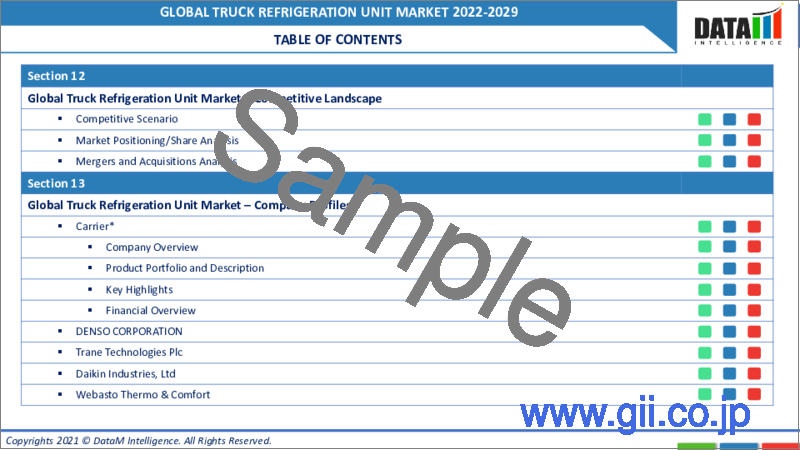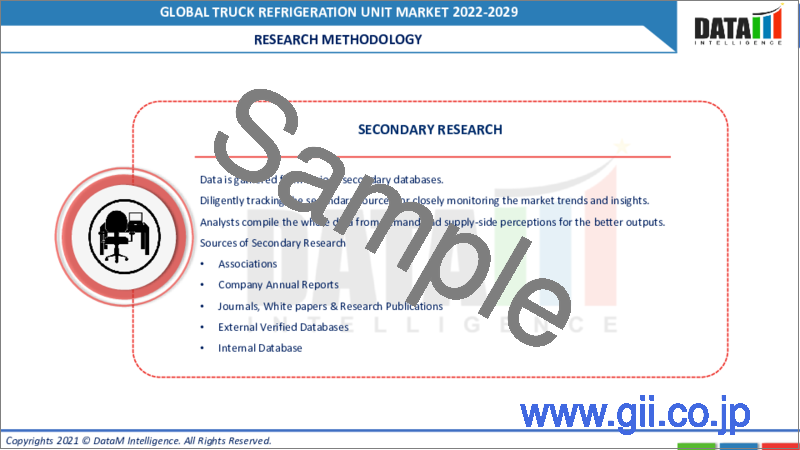|
|
市場調査レポート
商品コード
1074168
トラック冷凍ユニットの世界市場:2022年~2029年Global Truck Refrigeration Unit Market - 2022-2029 |
||||||
|
● お客様のご希望に応じて、既存データの加工や未掲載情報(例:国別セグメント)の追加などの対応が可能です。 詳細はお問い合わせください。 |
|||||||
| トラック冷凍ユニットの世界市場:2022年~2029年 |
|
出版日: 2022年05月07日
発行: DataM Intelligence
ページ情報: 英文 210 Pages
納期: 約2営業日
|
- 全表示
- 概要
- 目次
当レポートでは、世界のトラック冷凍ユニットの市場を調査し、市場の定義と概要、市場成長への各種影響因子の分析、法規制環境、市場規模の推移・予測、各種区分・地域/主要国別の内訳、競合環境、主要企業のプロファイルなどをまとめています。
目次
第1章 世界のトラック冷凍ユニット市場:調査手法・調査範囲
第2章 世界のトラック冷凍ユニット市場:市場の定義・概要
第3章 世界のトラック冷凍ユニット市場:エグゼクティブサマリー
第4章 世界のトラック冷凍ユニット市場:市場力学
- 市場影響要因
- 促進要因
- 抑制要因
- 市場機会
- 影響分析
第5章 世界のトラック冷凍ユニット市場:産業分析
- ポーターのファイブフォース分析
- サプライチェーン分析
- 価格分析
- 規制分析
第6章 世界のトラック冷凍ユニット市場:COVID-19の分析
- COVID-19:市場への影響分析
- COVID-19渦中の価格ダイナミクス
- 需給スペクトル
- パンデミック時の政府の市場関連イニシアチブ
- 製造業者の戦略的イニシアチブ
- 総論
第7章 世界のトラック冷凍ユニット市場:システム別
- スプリットシステム
- ルーフマウントシステム
第8章 世界のトラック冷凍ユニット市場:車両別
- 小型商用車
- 大型商用車
- トレーラー
第9章 世界のトラック冷凍ユニット市場:サイズ別
- 20フィート
- 40フィート
- その他
第10章 世界のトラック冷凍ユニット市場:産業別
- 冷凍食品
- 医薬品
- 化学
- その他
第11章 世界のトラック冷凍ユニット市場:地域別
- 北米
- 欧州
- 南米
- アジア太平洋
- 中東・アフリカ
第12章 世界のトラック冷凍ユニット市場:競合情勢
- 競合シナリオ
- 市場の位置付け/シェア分析
- M&A分析
第13章 世界のトラック冷凍ユニット市場:企業プロファイル
- Carrier
- Denso
- Trane Technologies
- Daikin Industries
- Webasto Thermo & Comfort
- Mitsubishi Heavy Industries
- VBG Group AB
- Klinge Corporation
- Sanden Holdings Corporation
- FRIGOBLOCK
第14章 世界のトラック冷凍ユニット市場:重要考察
第15章 世界のトラック冷凍ユニット市場:DataM
- 付録
- 当社・サービスについて
- コンタクト
Market Overview
The global truck refrigeration unit market size was worth US$ XX million in 2021 and is estimated to reach US$ XX million by 2029, growing at a CAGR of XX% during the forecast period (2022-2029).
A truck refrigeration unit refers to a mechanical refrigeration system used to transport perishable goods such as fruits, vegetables, meat and poultry over long distances by road. The truck refrigeration unit consists of a compressor, condenser and evaporator. The truck engine drives the compressor and compresses a low-temperature, low-pressure refrigerant into high-temperature, high-pressure gas.
The condenser changes the state of the gas into liquid through heat exchange. The evaporator is positioned in the cargo area and uses a thermostatically controlled expansion valve to convert the liquid refrigerant into a low-pressure, low-temperature gas. The cycle is repeated until the desired temperature is obtained.
Market Dynamics
The demand for truck refrigeration unit systems is driven primarily by the increasing global consumption of frozen foods due to modern lifestyle choices. The rising health concerns of long-term consumption of frozen foods represent a key challenge for the growth of this market.
Increasing global consumption of frozen foods
Modern lifestyles, increased disposable incomes, strong economic growth and globalization have caused changes in food habits globally. Trends indicate an increasing demand among consumers for quick and easy meals, especially among the emerging markets of Asia-Pacific, Middle-East & Africa. Ready-to-eat meals primarily fulfill the demand and local and global quick-service restaurant chains such as KFC and Mcdonald's. Ready-to-eat meals are typically flash-frozen and only require heating to serve.
Quick service restaurants rely on batches of pre-cooked frozen food that can be just heated to ensure prompt service. Global trade has ensured the availability of a wide variety of choices for the average consumer. Due to refrigerated transport, the most exotic fruits, vegetables, seafood and meats globally are available in local grocery supermarkets. The ever-increasing consumption of frozen foods will drive the global truck refrigeration unit market trends.
Health concerns about the consumption of frozen foods
Modern lifestyles and increased disposable incomes have seen a big rise in the global consumption of frozen foods. However, most frozen foods are processed and contain high sodium, trans fats, saturated fats and added sugar. The consumption of unhealthy processed frozen foods leads to health complications such as diabetes and heart disease. The World Health Organization (WHO) estimates heart disease as the leading cause of death globally, with nearly 17.9 million deaths in 2020.
It has also raised concerns about the alarming increase in the rates of diabetes, especially in the developing world. The health effects of frozen food consumption are gaining widespread attention and are prompting a global debate about modern lifestyle choices. The increasing health concerns about the consumption of frozen foods will be a key challenge for the growth of the global truck refrigeration unit market since the frozen food industry is the single largest user of this market.
COVID-19 impact analysis
Due to the COVID-19 pandemic, the manufacturing industry saw a significant drop in production and sales in 2020. To stop the disease from spreading, governments globally instituted lockdowns and many manufacturers had to halt operations temporarily. Because industrial manufacturing is a capital-intensive industry, several component makers were on the verge of bankruptcy. After the lockdowns were lifted, production continued at a limited capacity.
The COVID-19 pandemic's knock-on effects on global supply chains have resulted in shortages of critical automobile components. Even after the pandemic-related limitations were lifted completely, long lead times and lower production rates were observed. The industry has struggled to meet demand, especially for the global COVID-19 vaccine rollout. The pandemic had a negligible impact on long-term growth of the truck refrigeration unit market since the consumption of frozen foods and pharmaceuticals will continue to increase in the coming years.
Segment Analysis
The truck refrigeration unit market is segmented into system, vehicle, size, industry and region. The global truck refrigeration unit market is segmented into frozen food, pharmaceutical, industrial and others. Frozen food dominates this segment as the largest use of truck refrigeration units is for transportation of fruits, vegetables, meat, seafood and other perishable food items.
Geographical Analysis
Asia-Pacific is leading in the global truck refrigeration unit system market. The region accounts for the largest market share, primarily due to major emerging markets such as India, China, Indonesia, Malaysia, Thailand and Vietnam and developed markets like Japan and South Korea.
The sustained high economic growth experienced by this region has led to increased disposable incomes and the adoption of modern lifestyle practices. It has generated a huge demand for ready-to-eat meals and fast-food restaurants. All the major global fast-food brands, such as KFC, McDonald's, Subway, Pizza Hut etc., have a presence in this region and are rapidly scaling up operations.
The Asia-Pacific is also home to some of the largest pharmaceutical producers, namely, China, Japan and India. China and India are the largest manufacturers of Active Pharmaceutical Ingredients (APIs) and India is the largest vaccine manufacturer globally. The above factors make the Asia-Pacific the dominant region for the global truck refrigeration unit market. The market share of the Asia-Pacific will only increase in the coming years.
Competitive Landscape
The global truck refrigeration unit market is highly competitive due to the availability of a wide variety of proprietary refrigeration systems for different applications. Some of the major players contributing to the growth in the segment are Carrier, Denso, Trane Technologies, Daikin Industries, Webasto Thermo & Comfort, Mitsubishi Heavy Industries, VBG Group AB, Klinge Corporation, Sanden Holdings Corporation, FRIGOBLOCK. The major market players adopt several growth strategies such as the launch of new products, acquisitions and mergers, joint ventures, collaborations and regional and global expansion, contributing to global growth in the industry.
Carrier
Overview: Carrier is a major engineering company interested in refrigeration, air-conditioning, fire security systems and home appliances. The company was founded in 1915 by engineer Willis Carrier, considered the father of modern air-conditioning and is headquartered in Palm Beach Gardens, Florida, U.S.
Product Portfolio
40X is a vehicle engine-driven truck refrigeration unit. The system has fully automatic controls and can operate in temperatures of up to 38℃.
Key Developments: In 2020, Carrier launched the Supra S9, a new refrigeration unit for large diesel trucks ranging from 10 to 28ft in length. The company claims the new unit consumes 50% less refrigerant than previous models and provides a 20% more cooling effect.
Why Purchase the Report?
Visualize the composition of the truck refrigeration unit market segmentation by system, vehicle, size, industry and region, highlighting the critical commercial assets and players.
Identify commercial opportunities in the truck refrigeration unit market by analyzing trends and co-development deals.
Excel data sheet with thousands of global truck refrigeration unit market-level 4/5 segmentation data points.
PDF report with the most relevant analysis cogently put together after exhaustive qualitative interviews and in-depth market study.
Product mapping in excel for the critical product of all major market players
The global truck refrigeration unit market report would provide access to an approx.: 65 market data tables, 67 figures and 210 pages.
Target Audience 2022
Automotive component manufacturers
Vehicle manufacturers
Industry Investors/Investment Bankers
Education & Research Institutes
Research Professionals
Table of Contents
1. Global Truck Refrigeration Unit Market Methodology and Scope
- 1.1. Research Methodology
- 1.2. Research Objective and Scope of the Report
2. Global Truck Refrigeration Unit Market - Market Definition and Overview
3. Global Truck Refrigeration Unit Market - Executive Summary
- 3.1. Market Snippet by System
- 3.2. Market Snippet by Vehicle
- 3.3. Market Snippet by Size
- 3.4. Market Snippet by Industry
- 3.5. Market Snippet by Region
4. Global Truck Refrigeration Unit Market-Market Dynamics
- 4.1. Market Impacting Factors
- 4.2. Drivers
- 4.2.1. Stringent fuel economy rules
- 4.2.2. XX
- 4.3. Restraints
- 4.3.1. Complexity and failure of electric power steering system components
- 4.3.2. XX
- 4.4. Opportunity
- 4.4.1. XX
- 4.5. Impact Analysis
5. Global Truck Refrigeration Unit Market - Industry Analysis
- 5.1. Porter's Five Forces Analysis
- 5.2. Supply Chain Analysis
- 5.3. Pricing Analysis
- 5.4. Regulatory Analysis
6. Global Truck Refrigeration Unit Market - COVID-19 Analysis
- 6.1. Analysis of COVID-19 on the Market
- 6.2. Before COVID-19 Market Scenario
- 6.3. Present COVID-19 Market Scenario
- 6.4. After COVID-19 or Future Scenario
- 6.5. Pricing Dynamics Amid COVID-19
- 6.6. Demand-Supply Spectrum
- 6.7. Government Initiatives Related to the Market During Pandemic
- 6.8. Manufacturers Strategic Initiatives
- 6.9. Conclusion
7. Global Truck Refrigeration Unit Market - By System
- 7.1. Introduction
- 7.1.1. Market Size Analysis and Y-o-Y Growth Analysis (%), By System
- 7.1.2. Market Attractiveness Index, By System
- 7.2. Split System
- 7.2.1. Introduction
- 7.2.2. Market Size Analysis and Y-o-Y Growth Analysis (%)
- 7.3. Roof Mount System
8. Global Truck Refrigeration Unit Market - By Vehicle
- 8.1. Introduction
- 8.1.1. Market Size Analysis and Y-o-Y Growth Analysis (%), By Vehicle Segment
- 8.1.2. Market Attractiveness Index, By Vehicle Segment
- 8.2. Light Commercial Vehicle (LCV)
- 8.2.1. Introduction
- 8.2.2. Market Size Analysis and Y-o-Y Growth Analysis (%)
- 8.3. Heavy Commercial Vehicle (HCV)
- 8.4. Trailer
9. Global Truck Refrigeration Unit Market - By Size
- 9.1. Introduction
- 9.1.1. Market Size Analysis and Y-o-Y Growth Analysis (%), By Size Segment
- 9.1.2. Market Attractiveness Index, By Size Segment
- 9.2. 20 Feet
- 9.2.1. Introduction
- 9.2.2. Market Size Analysis and Y-o-Y Growth Analysis (%)
- 9.3. 40 Feet
- 9.4. Others
10. Global Truck Refrigeration Unit Market - By Industry
- 10.1. Introduction
- 10.1.1. Market Size Analysis and Y-o-Y Growth Analysis (%), By Industry Segment
- 10.1.2. Market Attractiveness Index, By Industry Segment
- 10.2. Frozen Food
- 10.2.1. Introduction
- 10.2.2. Market Size Analysis and Y-o-Y Growth Analysis (%)
- 10.3. Pharmaceutical
- 10.4. Chemical
- 10.5. Other
11. Global Truck Refrigeration Unit Market - By Region
- 11.1. Introduction
- 11.1.1. Market Size Analysis and Y-o-Y Growth Analysis (%), By Region
- 11.1.2. Market Attractiveness Index, By Region
- 11.2. North America
- 11.2.1. Introduction
- 11.2.2. Key Region-Specific Dynamics
- 11.2.3. Market Size Analysis and Y-o-Y Growth Analysis (%), By System
- 11.2.4. Market Size Analysis and Y-o-Y Growth Analysis (%), By Vehicle
- 11.2.5. Market Size Analysis and Y-o-Y Growth Analysis (%), By Size
- 11.2.6. Market Size Analysis and Y-o-Y Growth Analysis (%), By Industry
- 11.2.7. Market Size Analysis and Y-o-Y Growth Analysis (%), By Country
- 11.2.7.1. U.S.
- 11.2.7.2. Canada
- 11.2.7.3. Mexico
- 11.3. Europe
- 11.3.1. Introduction
- 11.3.2. Key Region-Specific Dynamics
- 11.3.3. Market Size Analysis and Y-o-Y Growth Analysis (%), By System
- 11.3.4. Market Size Analysis and Y-o-Y Growth Analysis (%), By Vehicle
- 11.3.5. Market Size Analysis and Y-o-Y Growth Analysis (%), By Size
- 11.3.6. Market Size Analysis and Y-o-Y Growth Analysis (%), By Industry
- 11.3.7. Market Size Analysis and Y-o-Y Growth Analysis (%), By Country
- 11.3.7.1. Germany
- 11.3.7.2. UK
- 11.3.7.3. France
- 11.3.7.4. Italy
- 11.3.7.5. Spain
- 11.3.7.6. Rest of Europe
- 11.4. South America
- 11.4.1. Introduction
- 11.4.2. Key Region-Specific Dynamics
- 11.4.3. Market Size Analysis and Y-o-Y Growth Analysis (%), By System
- 11.4.4. Market Size Analysis and Y-o-Y Growth Analysis (%), By Vehicle
- 11.4.5. Market Size Analysis and Y-o-Y Growth Analysis (%), By Size
- 11.4.6. Market Size Analysis and Y-o-Y Growth Analysis (%), By Industry
- 11.4.7. Market Size Analysis and Y-o-Y Growth Analysis (%), By Country
- 11.4.7.1. Brazil
- 11.4.7.2. Argentina
- 11.4.7.3. Rest of South America
- 11.5. Asia-Pacific
- 11.5.1. Introduction
- 11.5.2. Key Region-Specific Dynamics
- 11.5.3. Market Size Analysis and Y-o-Y Growth Analysis (%), By System
- 11.5.4. Market Size Analysis and Y-o-Y Growth Analysis (%), By Vehicle
- 11.5.5. Market Size Analysis and Y-o-Y Growth Analysis (%), By Size
- 11.5.6. Market Size Analysis and Y-o-Y Growth Analysis (%), By Industry
- 11.5.7. Market Size Analysis and Y-o-Y Growth Analysis (%), By Country
- 11.5.7.1. China
- 11.5.7.2. India
- 11.5.7.3. Japan
- 11.5.7.4. South Korea
- 11.5.7.5. Rest of Asia-Pacific
- 11.6. Middle East and Africa
- 11.6.1. Introduction
- 11.6.2. Key Region-Specific Dynamics
- 11.6.3. Market Size Analysis and Y-o-Y Growth Analysis (%), By System
- 11.6.4. Market Size Analysis and Y-o-Y Growth Analysis (%), By Vehicle
- 11.6.5. Market Size Analysis and Y-o-Y Growth Analysis (%), By Size
- 11.6.6. Market Size Analysis and Y-o-Y Growth Analysis (%), By Vehicle
12. Global Truck Refrigeration Unit Market - Competitive Landscape
- 12.1. Competitive Scenario
- 12.2. Market Positioning/Share Analysis
- 12.3. Mergers and Acquisitions Analysis
13. Global Truck Refrigeration Unit Market- Company Profiles
- 13.1. Carrier
- 13.1.1. Company Overview
- 13.1.2. Product Portfolio and Description
- 13.1.3. Key Highlights
- 13.1.4. Financial Overview
- 13.2. Denso
- 13.3. Trane Technologies
- 13.4. Daikin Industries
- 13.5. Webasto Thermo & Comfort
- 13.6. Mitsubishi Heavy Industries
- 13.7. VBG Group AB
- 13.8. Klinge Corporation
- 13.9. Sanden Holdings Corporation
- 13.10. FRIGOBLOCK
LIST NOT EXHAUSTIVE
14. Global Truck Refrigeration Unit Market - Premium Insights
15. Global Truck Refrigeration Unit Market - DataM
- 15.1. Appendix
- 15.2. About Us and Services
- 15.3. Contact Us




